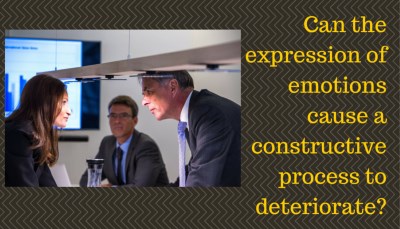

 Emotions and Conflict: More Complicated than We Think
Emotions and Conflict: More Complicated than We ThinkI was not at all prepared for the pushback I got when speaking to a distinguished group of conflict resolution and organization development professionals about resolving organizational differences. I had not questioned an assumption I have been making for decades, that expressions of strong feelings made in an emotional way, in the context of trying to resolve organizational issues, can cause a constructive process to deteriorate rapidly. This is a central thesis of my practice and of the model I developed and write about in my upcoming book, The Power of Difference.
The challenge to this assumption came in response to my discussion of ways to keep the focus on rational problem-solving, to acknowledge feelings then put them aside and model a calm demeanor. As I understand it, the concern centered on two propositions; the first suggesting that there is cultural bias inherent in the notion that ‘rational’ thought is of more value than emotional ways of processing. The second was that when harm has been done, whether great or small, perceived or real, the person harmed needs to have his/her emotional reaction heard.
These ideas made me stop and re-examine my long held belief. What was the basis for my assumptions? When, if ever, may they not be legitimate or the basis of best practices?
The answer to the first question, ‘where does this idea come from?’, is an easy one. I was reminded recently of Rational Emotive Therapy developed by Albert Ellis in the 1960’s which suggested people examine the rationality of their emotions. More recently, Daniel Goleman’s Emotional Intelligence construct explicitly teaches people to manage their emotions by increasing self-awareness and self control to allow for better decision making in interpersonal relations. Neuroscience has given us new understanding of the way in which primitive parts of our brain react to stimuli that is perceived as threatening before it can be processed by more advanced parts to produce a more reasoned (or rational) response, suggesting that we employ ways to buy time before we react. All of these bodies of work take for granted that unmanaged emotions can be a destructive force.
But why employ this method in the context of resolving differences in general and in organizations in particular? At the base of the concern about emotions getting us into trouble, is the reality that when we are confronted with another person’s expressed emotions, that in itself is very often perceived as dangerous. Why is that? Perhaps it’s because it makes the other person’s behavior harder to predict. For whatever the reason, it creates a situation in which the person on the receiving side of the emotional behavior is now struggling with his or her own emotional response. When this happens, it becomes much more difficult to hear the words being said and understand their meaning; what comes through is the emotions and the alarm that they provoke. This is all heightened by the fact that being in a discussion involving differences is inherently uncomfortable to begin with. The likelihood that a constructive conversation will continue is greatly diminished when strong emotions are expressed.
We also now know with certainty that being in a heightened emotional state makes it far more difficult to engage the parts of our brain that act as analytical processors. Differences in organizations, while they often do have emotional components, always have substantive concerns that need to be addressed. People refer to the ’emotional hijack’ when we get stuck in feelings to the detriment of our ability to think clearly and analytically.
Is there a legitimate case to be made for people needing to have their emotions acknowledged and understood? Absolutely! There should always be a time and a place for people to tell each other about how they have been impacted by one another and how it felt. I would argue for that happening in a way that both people can truly hear one another’s words and understand the other’s experience with empathy (another part of Daniel Goleman’s EQ) and compassion. In fact, when humans share their most human experiences, relationships are strengthened. The best way to make that happen is to be able to express emotions in a way that is not perceived as dangerous or threatening by the other person, that is, talking about emotions with a minimum of emotionally laden non-verbal behavior.
I’m still left with the question of cultural differences. Is it culturally insensitive to believe that for many, if not most, situations involving organizational differences, the best solutions are likely to emerge when people are engaged in clear-headed, data-based, problem-solving processes? How do we accept and accommodate our differences?
What do you think? Please add your comments below.